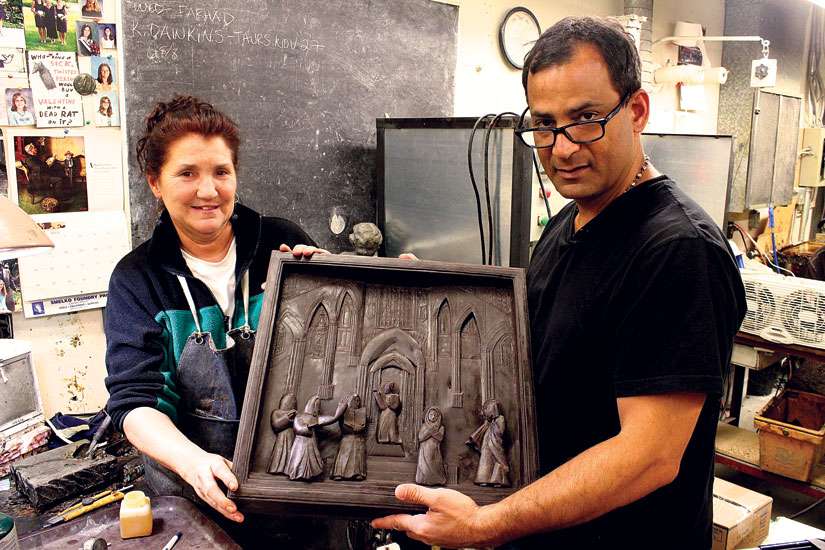“I get overwhelmed by the power of the story,” said sculptor Farhad Nargol O’Neil. “There are times when I realize that a minute or an hour or two hours have gone by and I have just been frozen there. I still have my chisels in my hand. But I am so deep within the story.”
As part of the St. Michael’s Cathedral restoration project, O’Neil was commissioned to carve all 20 mysteries of the rosary — four sets of five that cover almost the entire story of the Gospel, from the Annunciation to the Resurrection. Once complete, the 20 bronze panels will cover two doors on the north and south sides of the cathedral. The bronze doors will frame the backdrops of two chapels within the church, the Chapel of the Immaculate Heart of Mary and the Chapel of the Sacred Heart of Jesus. The chapels face off against each other at either end of the outward arms of the cross in the cathedral’s floor plan (a part of the church known as the transept). The joyful and glorious mysteries will frame the Chapel of the Immaculate Heart of Mary and the glorious and luminous mysteries will do the same for the Chapel of the Sacred Heart of Jesus.
Once complete, the doors will resemble the Gates of Paradise, a 16th-century masterpiece in Florence, Italy, by Lorenzo Ghiberti. The immense, ceremonial doors — one of the signature art works of the Renaissance — are O’Neil’s starting point. But the artist from Unionville, Ont., outside of Toronto is aiming for imagery that is simpler — less showy in terms of artistic technique. He wants his panels to point the way to the rosary devotions, not draw attention to themselves as works of art.
“For me, coming into a neo-Gothic space, I interpreted that as just Gothic — pre-Renaissance, 1,000 years ago — simplistic for us, a simplistic approach to the figure, leaning almost more to iconography,” he said.
Finding a simple, direct style is also about attracting people into one of the most basic devotions of Catholic spirituality and culture.
“This isn’t a dry devotional exercise,” said O’Neil. “I see this as a religious exercise more than an artistic, technical exercise. My development as a human being, as a man, as a Christian are locked into these things now and there’s no getting away from it.”
O’Neil’s path to this commission was not smooth. In 2013 he was ready to leave Canada and set up shop in Ireland, where he had begun his artistic career in the 1990s, or perhaps Italy. Canadians, O’Neil decided, seemed to have little interest in spirituality.
But his friend Cardinal Thomas Collins urged the artist to give Canada another chance and told him to approach St. Michael’s Rector Fr. Michael Busch. They got together in 2014, and since then it’s been a fever-dream of sketching, praying, carving and planning.
O’Neil moved his studio into the bell tower where until the end of July this year he drew, designed and redesigned the doors. Like the anonymous medieval painters and carvers who left their marks on the Gothic cathedrals of Europe, O’Neil found himself part of the community of construction workers, engineers, stone masons, gilders and carpenters working on the St. Michael’s renovation.
“My drawing has improved. My carving has improved. I’m able to do things now in an hour that used to take me a week,” he said. “The first panel took six months. The last panel took seven weeks. That’s about as quick as you can do it.” While elements of the first doors have been cast and gilded and O’Neil continues to carve and sketch, his work won’t be finished before the cathedral’s rededication on Sept. 29. He has been told “don’t rush it.”
“These are going to be here for generations if not hundreds of years,” he said.
He is amazed that the rosary hasn’t been more often and more thoroughly depicted in church art.
“Emotionally, I can’t think of a person on the planet who wouldn’t be moved by the story of the rosary,” he said.
Mary’s sorrows and joys in the life of her son can so easily become our own emotional life and so quickly connect us with our own humanity. It’s the story that makes this project more than art, more than church decoration, he said.




























